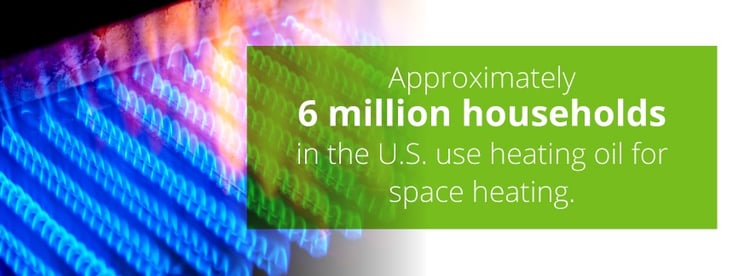Outside of the Northeastern U.S., few people realize home heating oil is now a clean-burning, eco-friendly source of thermal energy. If you live in one of the states that have already mandated the switch to ultra-low sulfur heating oil, also known as ULSHO, however, you’ve probably already heard about the merits of this new and improved version of an old petroleum product.
For years, inexpensive heating oil has been a mainstay of residences and businesses throughout states such as New York, New Jersey and Massachusetts. That’s because even during times when thermal fuels are at a premium, heating oil remains one of the relatively cheapest ways to warm homes. But with its black thick, oily exhaust, no one has ever accused heating oil of being a green source of energy, so how can it possibly be environmentally beneficial?
Most people think of heating oil exhaust as the same sooty smoke that once streamed out of Rudolf Diesel’s revolutionary engine in 1893, but that’s no longer necessarily the case. Thanks to the process of desulfurization, along with innovative biodiesel mixtures, today’s refined heating oil is considered one of the most environmentally friendly fossil fuels on the market.
What is Biodiesel and Why is it Mixed With Heating Oil?
As clean and environmentally friendly as ultra-low sulfur heating oil is, it is not a renewable source of energy. All petroleum products, referred to as “fossil fuels,” are the result of a natural process occurring over millions of years where the remains of plants and animals slowly convert to the oil and gases that we use for energy. Because nature requires an enormous amount of organic material and time to produce oil, these fuel sources don’t develop nearly at the pace that we consume them.
Biodiesel, on the other hand, is manufactured using things such as restaurant grease, animal fat and vegetable oil as precursors, and the production time is much shorter. It also has very low greenhouse gas emissions. The major drawback is it’s difficult to make enough of it to meet our current energy demands. Consequently, it’s currently combined with ultra-low sulfur heating oil to produce Bioheat® Fuel, which is a ULSHO-biodiesel highly efficient, clean fuel mixture.
The Diesel Fuel Revolution
Diesel is so closely related to home heating oil, it can be used to run an oil-based heating system.

Conversely, most of the heating oil types you would use in your home heating system can also be used in diesel engines. Just to be on the safe side, always check the manufacturer’s specifications before you switch fuels. The important thing to know is that both are derived from #2 distillate and have nearly identical properties.
Since 2014, the U.S. Environmental Protection Agency (EPA) has enforced a new standard for diesel fuels used in motor vehicles that calls for a maximum of 15 parts per million of sulfur. All diesel in the United States over the past two years has been ULSD fuel.
Now, in an attempt to further protect the environment and comply with state laws, the heating oil industry has begun to follow suit by processing and marketing a new form of refined heating oil with drastically reduced sulfur emission.
Normal high-sulfur heating oils (HSHO) have a sulfur content of approximately 5,780 parts per million (ppm). Low-sulfur heating oils contain about 332 ppms. Ultra-low sulfur heating oil, however, can contain as little as 15 ppm. That’s nearly a 99.74% sulfur reduction from HSOS.
How is Ultra-Low Sulfur Heating Oil Produced?
Like all petroleum products, ultra-low sulfur heating oil and ultra-low sulfur diesel are derived from pockets of crude oil lying below the ground, under the bed of the sea or trapped in shale rock. But that crude rarely has consistent properties. Crude oil has different:
- Weights
- Compositions
- Sulfur content
And while crude always varies from region to region, even the same oil well can produce different grades of crude.
When the crude oil is piped to the refinery, one of the first steps in the process is distillation. This involves the crude being heated at increasingly high temperatures. The lightest grades of crude evaporate at the lowest temperatures. It essentially boils off in order of its physical weight.
The vapors are trapped and collected. As the temperatures continues to rise, the next-heaviest category of gas also begins to evaporate and can be collected. One of the categorizations given to crude oil by the U.S. Energy Information Association is a weight rating from 1 to 6, with one being the lightest and 6 being the heaviest. No. 1 distillate and No. 2 distillate — the petroleum products that eventually becomes diesel and home heating oil — are distilled at 450-650 degrees Fahrenheit.
Yielding More Diesel and Gas Byproducts

Diesel and gasoline are two of the petroleum products highest in demand, but distillation alone doesn’t always produce enough diesel or gasoline by itself. To remedy this, refiners use a “cracking” process like thermal cracking or hydrocracking to further break down the crude oil hydrocarbon molecules. This yields more of the desired diesel, or heating oil, and gasoline byproducts. One of the difficulties with diesel and gasoline, though, is that they aren’t inherently clean-burning fuels.
Whether it’s burned in a vehicle or by an oil-based heating unit, common diesel fuel releases a tremendous amount of sulfur dioxide (SO2) into the atmosphere. This is due to the heavy presence of sulfides, disulfides and sulfur-based molecules in crude oil and petroleum distillates. To combat the problem of sulfur saturating the exhaust of diesel-burning engines, refiners have developed the process of hydrodesulfurization (HDS) to remove the sulfur component of diesel/heating oil fuels before they go to market.
Hydrodesulfurization introduces hydrogen atoms to the petroleum product under increased temperatures and pressure. In simple terms, the sulfur atoms attach other atoms to form new molecules that can be separated from the petroleum product, in this case, heating oil. Depending on the amount of processing the oil undergoes, the resulting product is low sulfur or ultra-low sulfur heating oil.
Why Are Refiners Producing More ULSHO?
In 2006, with certain exceptions, refiners were required to produce vehicle-fuel diesel with a sulfur content of no more than 15 ppm. But the EPA mandate only applied to vehicle fuels, and because it is more expensive to process ultra-low sulfur diesel, the improved fuel wasn’t immediately marketed for home use. Many states in the Northeast, where most heating-oil consumption occurs, began implementing state laws that mirror the federal diesel-fuel standard for vehicles.
In 2012, New York, which at the time had over a million households using heating oil, was the first northeastern state to set a home heating oil sulfur content standard to 15 ppm. Massachusetts, New Jersey and Vermont followed suit with a les- stringent 500 ppm standard in 2014, but are all going to require ULSHO by 2018.
In 2016, Maine instituted a 50 ppm million standard but will also require ULSHO by 2018. There has been proposed legislation in other northeastern states, and in time, ULSHO may be the only type of heating oil allowed to run vehicles and warm homes. So, in addition to contributing to the global effort to produce eco-friendly, clean-burning fuels, refiners are finding fewer domestic markets for non-ULSHO.
How Does ULSHO Compare to Other Fuels?
Over the last several decades, home-heating units became popular in northeastern residences for a variety of reasons, including:
- Proven reliability
- Low purchase price
- Low maintenance costs
- Fuel is relatively inexpensive
- Convenient fuel delivery
In recent years, many residents have moved away from heating oil as thermal energy source, opting for natural gas or electrical heating systems. At one time, this might have been the ecologically responsible choice, but changing over heating systems involves an often involved a significant cash outlay.
But there’s good news for anyone who owns a heating oil system and was dreading the expense of a system change. Ultra-low sulfur heating oil and ULSHO-biodiesel mixtures work great in existing heating oil systems, are cost effective, and produce even fewer greenhouse gas emissions than natural gas.
Here’s how ULSHO compare to other fuels in a similar class:
- Biodiesel – From an end user’s perspective, the performance factors of Biodiesel and ULSHO are a near match. Biodiesel, while renewable, is more expensive to make than ULSHO. For that reason, the two are often combined to make Bioheat® Fuel, which burns cleaner than nearly all other fossil fuels.
- Gasoline – Traditionally, gasoline burned cleaner than heating oil, but wasn’t as efficient. Heating oil had cost a little more, but because of the improved efficiency, there’s more of an energy yield. ULSHO is highly efficient and burns cleaner than gasoline, but there is a premium built into the price due to the additional processing required to produce it.
Do You Need to Make Modifications When Using ULSHO?
Conventional thinking is natural gases are clean burning and therefore safer for the environment. But a congressional report by the National Oilheat Research Alliance (NORA) demonstrated Bioheat fuel — ultra-low sulfur heating oil mixed with biodiesel — produced lower greenhouse gas emissions than natural gas, like propane and butane.

According to the NORA report, biodiesel blends with ULSHO at 20% have lower greenhouse gases than natural gas over a century, and blends of 2% are lower in a span of just 20 years.
When the mixture is 20% biodiesel and 80% ULSHO, it produces fewer greenhouse gas emissions than natural gas when measured over a projected hundred-year period. The hundred-year period is used because some forms of greenhouse gas take longer to dissipate than others, so the total impact has to be measured over time. The same findings applied to the 2% mixture but over a 20-year period.
The report also states that a small mixture of biodiesel fuels doesn’t negatively impact the operation of oil heating systems and doesn’t increase the cost of fuel. The bottom line is ultra-low sulfur heating oil blended with biodiesel fuels works just as well as pure ULSHO but has even fewer greenhouse gas emissions than unblended ULSHO.
Fuel Costs
How much does ULSHO cost compared to conventional heating oil? While the base price for ULSHO is higher than conventional heating oil due to the additional processing, the price difference is offset by increased efficiency. So you may pay a little more for ULSHO — if you live in a state where it’s mandated, you may not have a choice — but the fuel you buy will last longer. And don’t forget you’re also helping the environment.
Equipment Maintenance
The reduction of sulfur in heating oil won’t negatively impact your home heating system. On the contrary, when sulfur is released as your heating oil burns, it can build up in the exhaust system of your oil heater. This:
- Creates scaling
- Creates pitting
- Eventually leads to reduced efficiency
Sulfur in the exhaust adds no benefit to your heater, and oil heating systems work well with ULSHO, Bioheat® and other low-sulfur blends without modifications. Of course, you should check with the manufacturer or an oil heater maintenance professional to be sure.
Efficiency
There is an efficiency gain in both ULSHO and in the actual heating system. Your fuel will burn more cleanly giving you a small increase in thermal output, and the reduction in buildup will assist the operation of your unit.
Using It in the Winter – Gelling and Clouding
Most homeowners with oil-burning heaters are familiar with fuel clouding and gelling. When temperatures drop, paraffin wax crystals start to form in diesel and heating oil. These will sometimes form sludge or a gel, which can impede the performance of the heater.
Unfortunately, with ULSHO and Bioheat®, the temperatures at which the crystals begin to form are slightly higher than with conventional heating oil. This is due to the fact that the catalytic process used to make ULSHO reduces the size of the paraffin wax seeds that are precursors to the crystals. This effect can be combated with fuel additives that reduce the occurrence of clouding or gelling.
Most oil heater manufacturers recommend the use of an additive regardless of the type of oil that you use. Check your owner’s manual or their website for commercial product recommendations.
Heating Oil Usage in the U.S.
So, how important is it for the U.S. to switch to ULSHO? Here are the heating oil usage statistics:

- Approximately 6 million households in the U.S. use heating oil for space heating.
- In 2014, 3.6 billion gallons of home heating oil were sold in the Northeast.
- Oil-based home heating oil units usually burn from .8-1.7 gallons per hour when in use.
- As we established above, high sulfur heating oil has emissions of 5,780 ppm, as opposed to the 15 ppm maximum from ULSHO.
Considering the sulfur emissions from ULSHO are .26% of the same content in conventional heating oil, it would take you nearly 385 hours, or 16 days, burning clean ultra-low sulfur diesel to equal the output from one hour of burning the old heating oil product. Your sulfur emissions for an entire winter would be less than a single day’s output with high-sulfur heating oil.
Find the Right Solution With Smart Touch Energy
It’s impossible to know how big of a role the northeastern states’ reliance on heating oil plays in the global production of greenhouse gases or how big of a positive impact a switch to clean-burning heating fuels will have on climate change and other ecological concerns. It is clear, however, that fuels like ultra-low sulfur heating oil can make a difference. Contact Smart Touch Energy to learn more about your home heating options.



